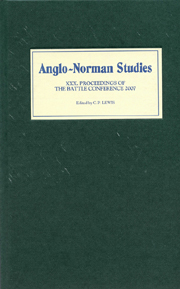Book contents
- Frontmatter
- Contents
- LIST OF ILLUSTRATIONS, MAPS, AND TABLES
- EDITOR'S PREFACE
- ABBREVIATIONS
- The Normans in Welsh History (R. Allen Brown Memorial Lecture)
- William Marshal, Lancelot, and Arthur: Chivalry and Kingship
- Grades of Ordination and Clerical Careers, c. 900–c. 1200
- Evesham J and Evesham L: Two Early Twelfth-Century Manorial Surveys
- Aspects of Church Reform in Wales, c. 1093–c. 1223
- Lay Charters and the Acta of Henry II
- Reinventing Normans as Crusaders? Ralph of Caen's Gesta Tancredi
- Kings, Lords, Charters, and the Political Culture of Twelfth-Century Wales
- Identifying the Warrior on the Pre-Heraldic Battlefield
- St Nicholas the Pilgrim and the City of Trani between Greeks and Normans, c. 1090–c. 1140
- The ‘Resurgence’ of Powys in the Late Eleventh and Early Twelfth Centuries
- Interpreter Families and Anglo-Welsh Relations in the Shropshire-Powys Marches in the Twelfth Century
- A Taste for the Antique? Henry of Blois and the Arts
St Nicholas the Pilgrim and the City of Trani between Greeks and Normans, c. 1090–c. 1140
Published online by Cambridge University Press: 12 September 2012
- Frontmatter
- Contents
- LIST OF ILLUSTRATIONS, MAPS, AND TABLES
- EDITOR'S PREFACE
- ABBREVIATIONS
- The Normans in Welsh History (R. Allen Brown Memorial Lecture)
- William Marshal, Lancelot, and Arthur: Chivalry and Kingship
- Grades of Ordination and Clerical Careers, c. 900–c. 1200
- Evesham J and Evesham L: Two Early Twelfth-Century Manorial Surveys
- Aspects of Church Reform in Wales, c. 1093–c. 1223
- Lay Charters and the Acta of Henry II
- Reinventing Normans as Crusaders? Ralph of Caen's Gesta Tancredi
- Kings, Lords, Charters, and the Political Culture of Twelfth-Century Wales
- Identifying the Warrior on the Pre-Heraldic Battlefield
- St Nicholas the Pilgrim and the City of Trani between Greeks and Normans, c. 1090–c. 1140
- The ‘Resurgence’ of Powys in the Late Eleventh and Early Twelfth Centuries
- Interpreter Families and Anglo-Welsh Relations in the Shropshire-Powys Marches in the Twelfth Century
- A Taste for the Antique? Henry of Blois and the Arts
Summary
In the first half of the twelfth century the Apulian coastal city of Trani was a key port and urban centre of its region, and one that was rapidly growing. The city had previously passed gradually from Byzantine to Norman rule during the period from the 1040s to the 1070s. By 1079 it was formally part of the Norman Robert Guiscard's duchy of Apulia. Nevertheless, from at least the 1080s until 1139 the city was, to all intents and purposes, politically independent; from 1085 until 1127 Guiscard's successors as dukes of Apulia had no real control along the Apulian coast, while from 1127 to 1139 the city, like all others on the mainland, was engulfed in civil war. The conflict had been sparked first by Roger II of Sicily's (successful) claim to the duchy of Apulia and was prolonged and embittered from 1130 by Roger's aim to go a step further and incorporate all of southern Italy into a unified kingdom, which he had finally achieved by 1139. In the process Trani slipped in and out of Roger's control until its definitive submission in 1139. However, our understanding of urban life within the city of Trani during this absorbing period from the 1090s to the 1140s is limited. There are only the briefest of references to the city in the narrative works of Falco of Benevento and Alexander of Telese, both of which tend to give snapshots of the city at moments of crisis and unrest.
- Type
- Chapter
- Information
- Anglo-Norman Studies 30Proceedings of the Battle Conference 2007, pp. 168 - 181Publisher: Boydell & BrewerPrint publication year: 2008



